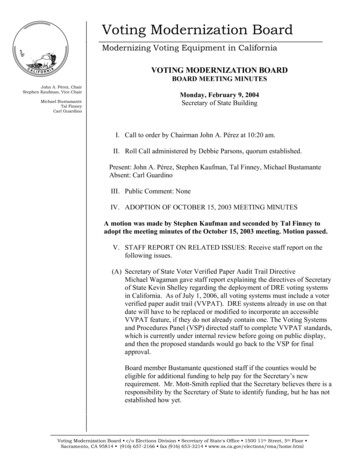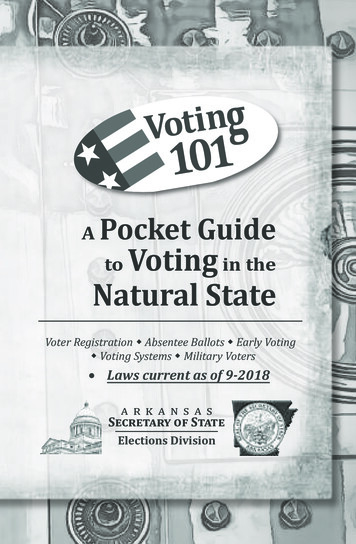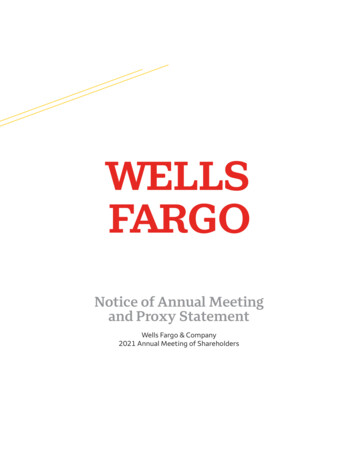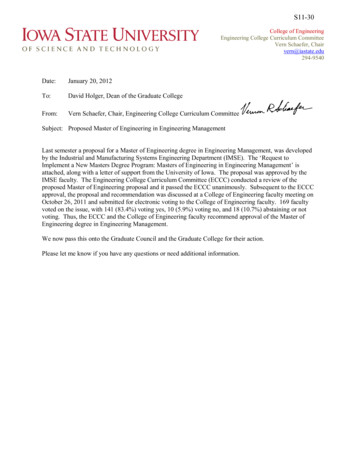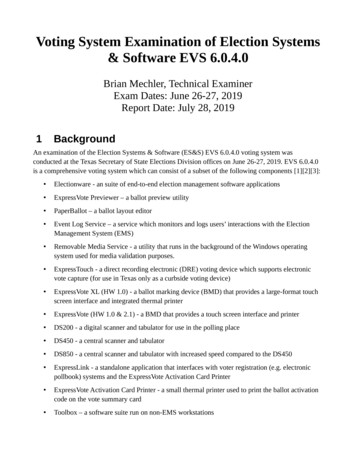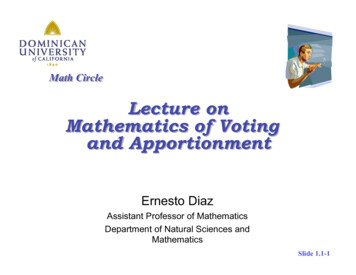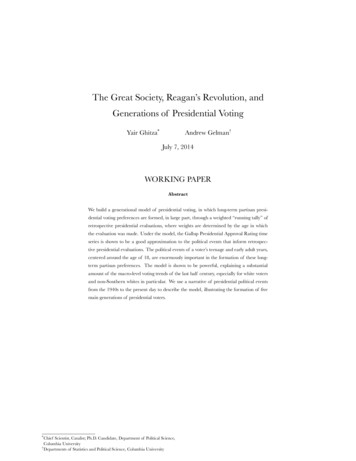
Transcription
Digital Voting with the use of Blockchain TechnologyTeam Plymouth Pioneers – Plymouth UniversityAndrew Barnes, Christopher Brake and Thomas PerryWord count: 2992
Contents1. Summary. 32. Introduction . 33. What is a Blockchain and how is it Commonly Used? . 44. Current Digital Voting Systems . 65. Our Proposal . 85.1 Registration . 85.2 Voting Mechanism and Architecture . 95.3 The Voting Process . 116. Analysis of the Design . 127. Conclusion . 138. References . 149. Appendix A – Assumptions . 1510. Appendix B . 162
1. SummaryThe aim of this report is to outline our proposal to solving the issues of digital voting by usingblockchain technology. The report starts by introducing the problems with current votingpractices, it then goes into a brief explanation of what blockchain technology is and how it iscurrently used. The following section looks at present day deployments of digital voting and theissues they face. The main section of the report is a detailed breakdown of our proposed designfollowed by an analysis of potential flaws and threats. The final section is a conclusion of howwe feel our design solves the issue at hand.2. IntroductionDemocratic voting is a crucial and serious event in any country. The most common way in whicha country votes is through a paper based system, but is it not time to bring voting into the 21stcentury of modern technology? Digital voting is the use of electronic devices, such as votingmachines or an internet browser, to cast votes. These are sometimes referred to as e-voting whenvoting using a machine in a polling station, and i-voting when using a web browser.Security of digital voting is always the biggest concern when considering to implement a digitalvoting system. With such monumental decisions at stake, there can be no doubt about thesystem’s ability to secure data and defend against potential attacks. One way the security issuescan be potentially solved is through the technology of blockchains.Blockchain technology originates from the underlying architectural design of the cryptocurrencybitcoin. It is a form of distributed database where records take the form of transactions, a block isa collection of these transactions. With the use of blockchains a secure and robust system for3
digital voting can be devised. This report outlines our idea of how blockchain technology couldbe used to implement a secure digital voting system.3. What is a Blockchain and how is it Commonly Used?Blockchain technology was first used within Bitcoin and is a public ledger of all transactions. Ablockchain stores these transactions in a block, the block eventually becomes completed as moretransactions are carried out. Once complete it is then added in a linear, chronological order to theblockchain.The initial block in a blockchain is known as the ‘Genesis block’ or ‘Block 0’. The genesis blockis usually hardcoded into the software; it is special in that itdoesn’t contain a reference to a previous block. (‘GenesisBlock’, 2015) Once the genesis block has been initialised‘Block 1’ is created and when complete is attached to thegenesis block. Each block has a transaction data part, copiesof each transaction are hashed, and then the hashes are pairedand hashed again, this continues until a single hash remains;also known as a merkle root (Figure 1). The block header isFigure 1: Hash tablewhere the merkle root is stored. To ensure that a transaction cannot be modified each block alsokeeps a record of the previous blocks header, this means to change data you would have to4
modify the block that records the transaction as well as all following blocks, as seen in Figure 2.(Bitcoin.org, 2009)Figure 2: Simplified Bitcoin Block Chain (Source: Bitcoin.org, 2009)A blockchain is designed to be accessed across a peer-to-peer network, each node/peer thencommunicates with other nodes for block and transaction exchange. Once connected to thenetwork, peers start sending messages about other peers on the network, this creates adecentralised method of peer discovery. The purpose of the nodes within the network is tovalidate unconfirmed transactions and recently mined blocks, before a new node can start to dothis it first has to carry out an initial block download. The initial block download makes the newnode download and validate all blocks from block 1 to the most current blockchain, once this isdone the node is considered synchronised.5
4. Current Digital Voting SystemsA number of digital voting systems are currently in use in countries around the world. Weresearched some of these systems to familiarise ourselves with current implementations,particularly Estonia.Estonia has had electronic voting since 2005 and in 2007 was the first country in the world toallow online voting. In the 2015 parliamentary election 30.5% of all votes were made though thenation’s i-voting system (Vabariigi Valimiskomisjon, 2016). The bases of this system is thenational ID card that all Estonian citizens are given. These cards contain encrypted files thatidentify the owner and allows the owner to carry out a number of online and electronic activitiesincluding online banking services, digitally signing documents, access their information ongovernment databases and i-voting. (Electronic ID Card, no date)In order to vote, the voter must enter their card into a card reader and then access the votingwebsite on the connected computer. They then enter their PIN number and a check is made to seeif they are eligible to vote. Once confirmed, they are able to cast/change their vote up until fourdays before election day. The voter may also use a mobile phone to identify themselves for ivoting if they do not have a card reader for their computer. However, this process requires aspecialised SIM card for the phone. (Estonian Ministry of Foreign Affairs, 2015)When a voter submits their vote, the vote is passed though the publicly accessible voteforwarding server to the vote storage sever where it is encrypted and stored until the onlinevoting period is over. Then the vote has all identifying information cleaned from it and istransferred by DVD to a vote counting server which is disconnected from all networks. This6
server decrypts and counts the votes and then outputs the results. Each stage of this process islogged and audited.During the 2013 Local Election, researchers observed and studied the i-voting process andhighlighted a number of potential security risks with the system. One such risk is the possibilityof malware on the client side machine that monitors the user placing their vote and then laterchanging their vote to a different candidate.Another possible risk is for an attacker to directly infect the servers though malware being placedon the DVDs used to set up the servers and transfer the votes. (Springall et al., 2014) However,this report has also come under criticism from the Estonian Information Systems Authority.(Veldre, 2014)Figure 3: Estonian Digital Voting System (Source: R. Verbij. "Dutch e-voting opportunities." Master thesis,University of Twente, 2014)7
5. Our ProposalFor our design we tried to create a system that doesn’t entirely replace the current voting butrather integrates within a current system. We decided to do this to allow for as many differentways to vote as possible, this is so voting can be accessed by the majority of the population.5.1 RegistrationThe first aspect of our design is the registration process, verifying a voter is essential inestablishing security within the system. Making sure that someone’s identity isn’t being misusedfor fraudulent purposes is important, especially when voting is considered, where every votematters. A design of our registration process can be found in Appendix B Figure 4. To allowusers to register to vote our proposed service utilizes both postal based forms as well as webforms requiring the same information to ensure we cater for those without a direct internetconnection. This information includes their national identity number (an example would be a UKcitizen’s national insurance number), postal address, optional email address and a password. Allof this information then forms a transaction for the user agreeing with the government that theyare asking to vote; this transaction is then created on the voter blockchain which is distinctlydifferent from the vote blockchain.Once someone has registered an automated government miner analyses the transaction and ifthey haven’t been awarded or denied a vote the miner will make the decision as to whether toverify the user or not. If the user is verified, they will be sent a ballot card with their informationon it to both their home address and email address if provided. They will also be sent a randomlygenerated password to use on the polling stations. Once this correspondence has been sent, the8
miner will create a transaction giving the user a vote from an infinite government pool of voteson the voter blockchain.During this process, a voter blockchain is used to keep a record of both transactions taking placeat each stage of this process for each voter:1. Firstly, a transaction is created when a user ‘registers’.2. The next transaction is created when a government miner authorizes that user’s right tovote.After the correspondence is received by the user they can then await voting to open to use theircredentials to vote. It is important to note that this voter blockchain will never contain details ofthe vote cast by the user.5.2 Voting Mechanism and ArchitectureWhen deciding on the architecture we took strong inspiration from both the distributed andavailability of the Bitcoin network and the aggregation process of traditional voting. The networkis a multi-tiered, decentralised infrastructure which houses the two distinct blockchains, thenetwork is divided into three abstract tiers, National, Constituency and Local. (Appendix BFigure 5)The local tier contains all the digital polling stations across the country, each of which isassociated to a constituency node. A local node is setup to only communicate with the other localnodes under the associated constituency node and the constituency node itself.The constituency tier contains all the nodes that are deemed to be at a constituency level. Thesenodes would be directly connected to each other and to a subset of polling stations depending on9
location. The national tier is a collection of nodes that are not tied to location, their pure purposeis to mine transactions and add blocks to the vote blockchain, all constituency nodescommunicate to a national node and national nodes can communicate with each other.Independent bodies will monitor and audit the voting process. These bodies will host or haveaccess to a national node and will be able to verify that the unencrypted results match theencrypted votes. Individuals and organisations can volunteer to be a national node. Theseapplications are processed by the government to ensure that they meet the minimumrequirements set by a governing body. These individuals will also act as miners during countingprocess.As part of our design we have an encryption method based on public and private keys and haveimplemented a structure where the data is segregated within the blockchain. This segregation hasbeen achieved by getting the constituency level nodes to generate keys pairs. The public keys arethen distributed to the connected polling station nodes, which then use the public key to encryptany vote made to that polling station. The data is then stored in an encrypted format within theblockchain and propagates out to the entire network.Due to the fact each constituency will have a different public key means that chunks of datawithin the block chain will be encrypted differently to a chunk of data next to it. We decided toapply this method to prevent any one person being able to decrypt the voting data before the endof voting deadline. If a hacker manages to get hold of a constituency private key, they wouldonly be able to decrypt certain sections of the blockchain, so would never know the full outcomeof the vote. Once the voting deadline has passed, the software within the constituency nodes10
publishes the private keys to allow the blockchain network to decrypt the data, which in turnmeans the votes can then be counted. A diagram of this can be seen (Appendix B Figure 7)5.3 The Voting ProcessWhen it is time to vote, authentication of a user requires three distinct pieces of evidence; theiridentification number (e.g. UK citizens have national insurance numbers), the password suppliedon registration, their ballot card which contains a QR code. As there are two methods of voting(web browser, physical polling station) the way the user will input the authentication details shalldiffer; however, in order to vote they are required to provide all three pieces of information. It isalso important to note that each user will have been registered at a certain constituency so theywill only be able to vote at a local polling station within that constituency or via the internet atthe URL provided on the ballot card. (Each constituency is to be equipped with its own webserver and URL to ensure votes are aggregated within the right network.)Behind the scenes the polling station will consult the voter blockchain to ensure the voter has notalready used up their vote. If the user does have a vote, then the station will then allow the userto continue to the voting screen. If not, then system will respond to the user appropriately. Seediagram Appendix B Figure 6 to see the process.After selecting their vote (from the selection of options including abstention) and thenconfirming the submission, the vote will become a transaction, it will be encrypted with therelevant constituency’s public key. This transaction is then passed to the constituency nodewhere it is added to a block and the update is then pushed to all other nodes connected to thatparticular constituency node. The connected nodes then pass the data on to their peers until thewhole network is updated. Once the vote has been confirmed the polling station will then11
generate a transaction to remove the user’s vote within the voter blockchain. It is important tonote that there are two distinct blockchains being held; one which contains transactions relatingto which users have registered and which users still have a vote, the second containing thecontents of the vote (such as what party was voted for.). Through the use of these two distinctblockchains we ensure voter anonymity when selecting their vote.6. Analysis of the DesignWithin our proposal we have tried to design a service and system that minimises the size ofattack vectors to prevent potential malicious attacks. We have tried to evaluate and analyse ourdesign from various perspectives to make sure we have thought about each step of the votingprocess. This section of the report discusses the potential risks associated with our proposal andsuggests actions that can be taken to help mitigate them.One risk is if a voter were to forget their ID, password or polling card on the day of voting. Inthis case the voter will be unable to cast their vote as they cannot enter the system. Possible riskmitigations include the voter returning later that day with the correct information or theimplementation of a backup authentication service such as by phone. Alternatively, a forgottenpassword system could be added to the voter registration website; this could work in much thesame way as recovering a password works on other websites. However, this increases the risk ofa hacker attempting to change a voter’s password without their knowing.A 51% attack is a potential threat to our proposed design. The basis of the attack being thatsomeone could theoretically control a majority of the digital voting mining hash-rate, leading tothem being able to manipulate the public ledger. The chances of this type of attack occurring areslim due to the immense cost needed to purchase hardware capable of this scale of processing.12
We also have the added security of an auditor who checks and keeps track of people connectingto the network and the locations of each node. This is a feature that current systems such asbitcoin lack. (Learncryptography.com, 2016)The online aspect of the voting within our system is the largest attack vector for hackers as theycould potentially exploit voters through their own devices in a host of ways. To combat thissoftware could be developed that could be downloaded onto the clients device to establish asecure connection to the polling station.7. ConclusionTo close, our service proposal comprises of a geographically distributed network comprising ofmachines from both government and public infrastructure; this infrastructure houses twodistinctly separate blockchains, one for voter information such as who has voted and the other forvote information such as what has been voted. These blockchains are held completely separatelyto remove any threat to link votes for certain parties back to individual voters while maintainingthe ability to track who has voted and how many votes are actually present.The blockchain containing information of who has registered to vote also allows our service toensure each voter in unique and as described in section 5.1. Once registered you are thenallocated a vote after verification of your details has been completed. To ensure these registeredvoters are who they say they are when voting begins there is a 3 factor authentication method asdescribed in section 5.3. Further to this we also need to ensure they are not forced to vote in aparticular way so we have incorporated a double-check service where by users shall be prompteda second time to confirm their submission before the vote is sent; this also then allows us toalmost eradicate accidental votes.13
Also, due to the encryption mechanism we are using (as described in section 5.3) it would beclose to impossible for any person(s) to gain access to all the votes without first taking control ofthe entire service network. Moving on from this the publication method of the private keysallows anyone to read the blockchain of votes and decrypt them with the newly availableconstituency private keys to verify the result of the election.8. ReferencesBitcoin.org (2009) Bitcoin Developer Guide. Available at: overview (Accessed: 27 September 2016)Electronic ID Card (no date) Available at: /(Accessed: 25 September 2016).Estonian Ministry of Foreign Affairs (2015) Estonian Internet Voting System. Available ting%20system.pdf (Accessed:25 September 2016)Genesis block (2015) Available at: https://en.bitcoin.it/wiki/Genesis block (Accessed 27September 2016)Learncryptography.com. (2016). Learn Cryptography - 51% Attack. Available -attack (Accessed 29 Sep. 2016).Springall, D., Finkenaur, T., Durumeric, Z., Kitcat, J., Hursti, H., MacAlpine, M., Halderman,J.A. (2014) Security Analysis of the Estonian Internet Voting System. Available df (Accessed: 25 September 2016)14
Vabariigi Valimiskomisjon (2015) Available at: x/statistics (Accessed: 25 September 2016).Veldre, A. (2014) E-Voting is (too) Secure. Available at: https://www.ria.ee/en/e-voting-is-toosecure.html (Accessed: 27 September 2016)9. Appendix A – Assumptions1. The country uses a constituency based system for elections.2. All eligible voters have a unique identifying number or other such reference.3. There is a stable and consistent internet connection to all polling stations.15
10. Appendix BFigure 4: Registration Architecture16
Figure 5: Overview of Node Architecture17
Figure 6: Diagram of Voting Architecture18
Figure 7: Diagram of Key Pair Encryption19
6 4. Current Digital Voting Systems A number of digital voting systems are currently in use in countries around the world. We researched some of these systems to familiarise ourselves with current .


